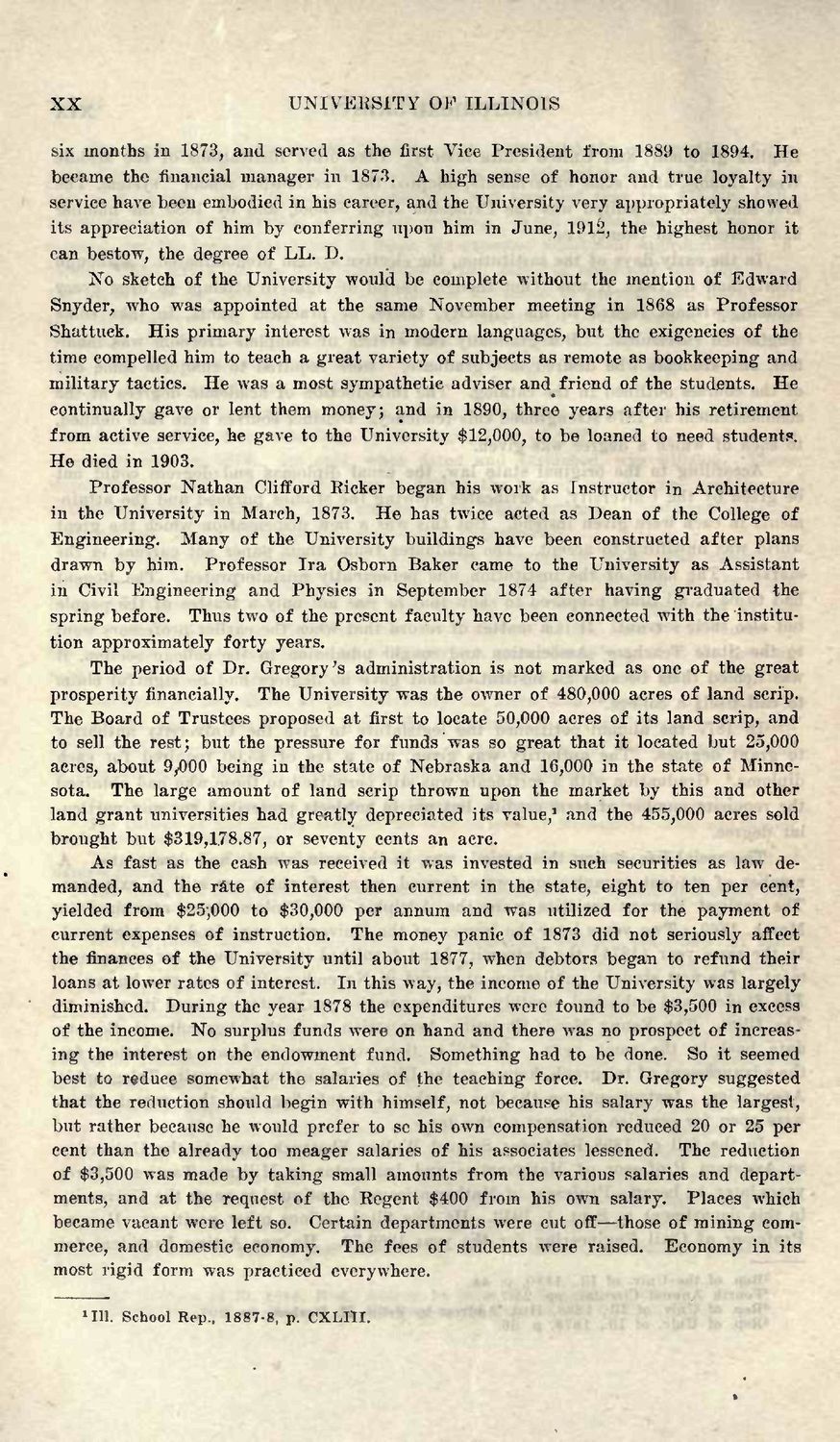| |
| |
Caption: Book - Early History of University (1916)
This is a reduced-resolution page image for fast online browsing.

EXTRACTED TEXT FROM PAGE:
XX UNIVERSITY 01-' I L L I N O I S six months in 1873, and served as the first Vice President from 1889 to 1894. He beearne the financial manager in 1873. A high sense of honor and true loyalty in service have been embodied in his career, and the University very appropriately showed its appreciation of him by conferring upon him in June, 1912, the highest honor it can bestow, the degree of LL. D. No sketch of the University would be complete without the mention of Edward Snyder, who was appointed at the same November meeting in 1868 as Professor Shattuek. His primary interest was in modern languages, but the exigencies of the time compelled him to teach a great variety of subjects as remote as bookkeeping and military tactics. He was a most sympathetic adviser and friend of the students. H-e continually gave or lent them money; and in 1890, three years after his retirement from active service, he gave to the University $12,000, to be loaned to need student?. Ho died in 1903. Professor Nathan Clifford Bicker began his work as Instructor in Architecture in the University in March, 1873. H e has twice acted as Dean of the College of Engineering. Many of the University buildings have been constructed after plans drawn by him. Professor I r a Osborn Baker came to the University as Assistant in Civil Engineering and Physies in September 1874 after having graduated the spring before. Thus two of the present faculty have been connected with the institution approximately forty years. The period of Dr. Gregory's administration is not marked as one of the great prosperity financially. The University was the owner of 480,000 acres of land scrip. The Board of Trustees proposed at first to locate 50,000 acres of its land scrip, and to sell the rest; but the pressure for funds was so great that it located but 25,000 acres, about 9,000 being in the state of Nebraska and 16,000 in the state of Minnesota. The large amount of land scrip thrown upon the market by this and other land grant universities had greatly depreciated its value, 1 and the 455,000 acres sold brought but $319,178.87, or seventy cents an acre. As fast as the cash was received it was invested in such securities as law demanded, and the rate of interest then current in the state, eight to ten per cent, yielded from $25-,000 to $30,000 per annum and was utilized for the payment of current expenses of instruction. The money panic of 1873 did not seriously affect the finances of the University until about 1877, when debtors began to refund their loans at lower rates of interest. In this way, the income of the University was largely diminished. During the year 1878 the expenditures were found to be $3,500 in excess of the income. No surplus funds were on hand and there was no prospect of increasing the interest on the endowment fund. Something had to be done. So it seemed best to reduee somewhat the salaries of the teaching force. Dr. Gregory suggested that the reduction should begin with himself, not because his salary was the largest, but rather because he would prefer to so his own compensation reduced 20 or 25 per cent than the already too meager salaries of his associates lessened. The reduction of $3,500 was made by taking small amounts from the various salaries and departments, and at the request of the Eegent $400 from his own salary. Places which became vacant were left so. Certain departments were cut off—those of mining commerce, and domestic economy. The fees of students were raised. Economy in its most rigid form was practiced everywhere. •111. School Rep., 1887-8, p. CXLIII.
| |